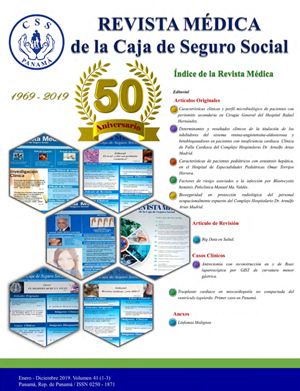CHARACTERISTICS OF PEDIATRIC PATIENTS WITH LIVER STEATOSIS, AT THE OMAR TORRIJOS HERRERA PEDIATRIC SPECIALTIES HOSPITAL, 2018
Main Article Content
Abstract
Introduction: Hepatic steatosis is a pathology characterized by excessive accumulation of fat in the form of triglycerides (steatosis) at the level of hepatocytes (> 5%). The incidence in children is 5.3% and 9.6%. The objective of the research was to describe the characteristics of pediatric patients with hepatic steatosis, treated at the Pediatric Specialty Hospital, in 2018.
Methods: Descriptive, cross-sectional and retrospective observational study.
Results: 73 patients, 45.21% corresponded to new patients. With a predominance of adolescents (60.27%) and in the male sex (51%), with origin the province of Panama (68.49%), with a tendency towards obesity. The clinical manifestations were: hepatomegaly (32.88%), acanthosis nigricans (41.10%) and jaundice (6.85%) In the biochemical analyzes we found that 42.47% had elevated aspartate aminotransferase and 45.21% alanine aminotransferase. The diagnostic imaging method was ultrasound (98.63%). Most did not have a liver biopsy (93.15%).
Conclusions: Hepatic steatosis occurred more frequently in adolescents. However, preschoolers and schoolchildren (30-35%) of the cases which is a wake-up call about eating and lifestyle habits. In addition, 42-45% presented elevation of transaminases, most studies recognize age as a risk factor and together both factors significantly increase the risk of cirrhosis, which would lead to a public health problem since Panama does not We have a pediatric liver transplant that is the cure for this condition. Keywords: hepatic steatosis, obesity, acanthosis nigricans, hepatomegaly, transaminases.
Downloads
Article Details
Issue
Section

This work is licensed under a Creative Commons Attribution-NonCommercial 4.0 International License.
How to Cite
References
1. Anderson EL, H. L. (2015). La prevalencia de la enfermedad del hígado graso no alcohólico en niños y adolescentes: una revisión sistemática y un metanálisis. Epub 2015 29 de octubre., p. 10.
2. Bejarano, & Forqueras. (2014). Hallazgo de Esteatosis Hepática en niños de 6 a 14 años con sobrepeso y obesidad en consultas ambulatorias en Cochabamba, Bolivia. Revista Científica Ciencia Médica, pp. 15-18.
3. Imata. (2006). Increased incidence of fatty liver in nonobeso Japanese children under 1 year of age with or without. Public Health, 120: pp. 176-178.
4. Kinugasa A, T. K. (1984). Fatty liver and its fibrous changes found in simple obesity of children. J Pediatr Gastroenterol Nutr, 3(3):p. 408.
5. Lawlor DA, C. M.-W. (2014). Nonalcoholic fatty liver disease, liver fibrosis, and cardiometabolic risk factors in adolescence: a cross-sectional study of 1874 general population adolescents. J Clin Endocrinol Metab., 99(3):p. 410.
6. Marginean CO, M. C. (2012 Aug;). Elastographic assessment of liver fibrosis in children:
7. Schwimmer JB, M. M. (2015 Jun). La resonancia magnética y la histología hepática como biomarcadores de esteatosis hepática en niños con enfermedad de hígado graso no alcohólico. Hepatology., 61(6):pp. 1887-1895.
8. Schwimmer JB, Z. A. (2014). Evaluación longitudinal de la presión arterial alta en niños con enfermedad del hígado graso no alcohólico. Plos One, p. 9.
9. Schwimmer, Jeffrey B. (2006). Prevalence of Fatty Liver in Children and Adolescents. Pediatrics, pp. 1388-1393.
10. Strauss RS, B. S. (2000). Prevalence of abnormal serum aminotransferase values in overweight and obese adolescents. J Pediatr, 136(6): p. 727.
11. Wu KT, K. P. (2016). La gravedad de la enfermedad del hígado graso no alcohólico se asocia con las proporciones de colesterol total y triglicéridos con respecto al colesterol de lipoproteínas de alta densidad. J Clin Lipidol., 10 : pp. 420 - 425 .

